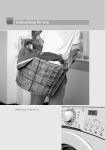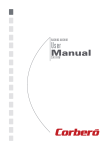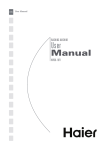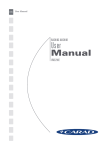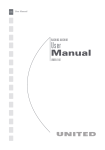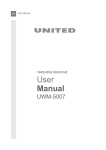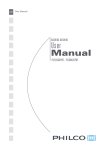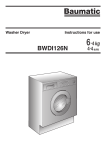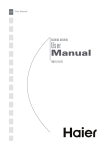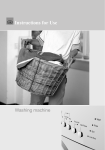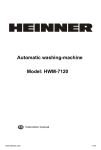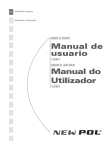Download User Manual - AEG Appliances
Transcript
EN User Manual WASHING MACHINE User Manual MODEL: L81400 CONTENTS CHAPTER-1: 4 BEFORE USING THE APPLIANCE • Correct Usage6-7 • General warnings 8-9-10-11 • Safety warnings 12-17 • Packaging and Environment 18 • Savings Information 19 CHAPTER-2: OVERVIEW OF YOUR DEVICE • General Appearance 20-21 • Techincal Specifications 22 CHAPTER-3: INSTALLATION • Removing transportation safety screws 23-24-25 • Adjusting Adjustable Stays 26-27 • Electrical connection 28 • Water inlet hose connection 29-30 • Water discharge connection 31 CHAPTER-4: INTRODUCTION OF CONTROL PANEL 32 • Detergent drawer 33-34 • Programme knob 35 • Electronic display 36-37 CONTENTS 5 CHAPTER-5: PRELIMINARY PREPARATION FOR LAUNDERING • Separating laundry • • 38-39 Putting laundry in the machine 40 Adding detergent into machine 41 • Operating your machine 42-44 • Auxiliary functions 45-50 • Child lock 51 • Cancelling programme 52 • Finishing programme 53 CHAPTER-6: PROGRAM TABLE 55-62 CHAPTER-7: MAINTENANCE AND CLEANING OF YOUR MACHINE • Warning 62 • Water inlet filters 63 • Pump filter 64-65 • Detergent drawer 66 CHAPTER-8: FLUSH STOPPER / BODY / DRUM 67 CHAPTER-9: TROUBLESHOOTING 68-72 CHAPTER-10: SOLUTIONS TO AUTOMATIC FAULT WARNINGS 74 CHAPTER-11: PRACTICAL INFORMATION • How to read the energy label and saving energy • Disposal of your old machine 74-75-76-77 80 78-79 CHAPTER -1: BEFORE USING THE APPLIANCE (CORRECT USAGE) 6 • Read the user manual. • Your machine is designed for domestic use. Commercial use will void your warranty. • Keep your pets away from your machine • Please check the packaging of your machine before installation, and the outer surface after the package have been opened. Do not operate damaged machines or machines with opened packages. • Have your machine installed only by an authorized service. Any interference to your machine by anyone other than authorized services shall cause your warranty to be void. • The appliance is not intended for use by people (including children) with reduced physical, sensory or mental capabilities, or lack of experience and knowledge unless they have been given supervision or instruction concerning use of the appliance by a person responsible for their safety. Children should be supervised to ensure that they do not play with the appliance. CHAPTER -1: BEFORE USING THE APPLIANCE (CORRECT USAGE) • Follow the manufacturer’s recommended instructions for your laundry. Refer to the care label on the fabric. • Before operating the washing machine, remove the 4 transportation screws and rubber spacers from the back of the machine. If the screws are not removed, it may cause heavy vibration, noise and product malfunction (voiding the warranty). • Your machine is not covered under warranty for faults caused by any kind of external factors (pesticides, fire, etc.). • Please do not throw away this user manual; keep it for future reference. You or somebody else might need it in the future. Note: Machinery specifications may vary depending on the product purchased. 7 CHAPTER -1: BEFORE USING THE APPLIANCE (GENERAL WARNINGS) 8 • The necessary ambient temperature for your machine’s ideal operation is 15-25°. • Frozen hoses can tear and crack. In regions where temperatures are below 0oC, ambient temperatures might endanger the safe operation of the internal circuit board. • Please ensure that the clothes you are placing into your machine do not contain any foreign substances (nail, needle, coins, lighter, matches, clip etc.) in their pockets. These foreign substances can damage your machine. • It is recommended to perform the first washing operation on the Cotton programme at 90˚ without laundry. Inserting ½ the amount of detergent in 2nd compartment of the detergent drawer. CHAPTER -1: BEFORE USING THE APPLIANCE (GENERAL WARNINGS) • Do not leave excess detergent or softener in the detergent compartment when the appliance is not in use. • It is advised that you unplug your machine and close the water inlet tap if you will not use your machine for a long time. Also, leaving the door of your machine open will prevent the formation of bad odors due to humidity. • Some water might be left in your machine after the trials and tests conducted due to Quality Control procedures. This will not damage your machine. • Remember that packaging materials of your machine may be dangerous for children. Keep the packaging materials in a place where children cannot reach or dispose of them appropriately. • Keep the small parts found in the document package away from the reach of children and infants. • Use pre-wash programs only for very dirty laundry. 9 CHAPTER -1: BEFORE USING THE APPLIANCE (GENERAL WARNINGS) • Never open the detergent compartment when the appliance is running. • In case of any breakdown, unplug the appliance first and then turn the tap off. Do not attempt to repair by yourself, always contact Euro-Parts (1.800.678.8352) or an authorized professional. • The amount of laundry you put in your washing machine should not exceed the maximum amount indicated. • Never force the door to open when the machine is running. 10 CHAPTER -1: BEFORE USING THE APPLIANCE (GENERAL WARNINGS) • Please adhere to the manufacturer’s guidelines regarding the use of detergents, fabric conditioners, or similar products in your machine. • Set up your machine in a place where its door can be completely opened. • Set up your machine at locations that can be fully ventilated and could have constant air circulation. 11 CHAPTER -1: BEFORE USING THE APPLIANCE (SAFETY WARNINGS) You must read these warnings. You can thus protect yourself and your beloved ones against fatal injuries and risks. DANGER OF GETTING BURNT! Do not touch discharging hose and water during discharging as the appliance may reach high temperatures when running. 12 CHAPTER -1: BEFORE USING THE APPLIANCE (SAFETY WARNINGS) DEATH RISK DUE TO ELECTRICAL CURRENT! • Do not use multiple receptacles or extension cords. • Do not plug in damaged or torn plugs. • Never pull the cable when unplugging – always grip the plug itself. • To prevent electrocution, DO NOT plug-in or unplug the appliance from the receptacle with wet hands. • Never touch the machine with wet hands or feet. • Call the nearest authorized service for a replacement if the power cord malfunctions. 13 CHAPTER -1: BEFORE USING THE APPLIANCE (SAFETY WARNINGS) Flooding risk! • Ensure that there are no blockages in the discharge hose before placing hose in the sink. • Take necessary measures to secure the discharge hose, to prevent the hose from slipping. • Ensure that your sink is clear from blockages to allow discharging water to drain. 14 CHAPTER -1: BEFORE USING THE APPLIANCE (SAFETY WARNINGS) Danger of Fire! • Do not keep flammable liquids near your machine. • The sulphur content of paint removers might cause corrosion. For this reason, never use paint-removing materials in your machine. • Never use products that contain solvent material. • Remove all the objects in the pockets of your laundry (needles, paperclips, lighters, matches etc.) before placing them in your appliance. Failing to do so will increase the risk of FIRE and EXPLOSION. 15 CHAPTER -1: BEFORE USING THE APPLIANCE (SAFETY WARNINGS) Fall and injury hazard! • Do not climb on your machine. The upper table of your machine may break and cause injury • Tidy/Secure all tripping hazards (hoses, cables, and packaging materials) of the appliance during installation. • Do not turn your machine upside down, or on its side. • Do not lift your machine by holding it from external parts (detergent drawer, door). They are not engineered to withstand the weight of the appliance. Appliance must be carried by 2 or more people. 16 CHAPTER -1: BEFORE USING THE APPLIANCE (SAFETY WARNINGS) 17 Child safety! • Do not leave children/infants unattended near the machine. Children/infants might lock themselves into the machine which serious injuries or death might occur. • Glass door and surfaces might be extremely hot while your machine is in operation. Avoid contact, especially with children. • Keep packaging material away from children. • Keep detergents and cleaning agents away from children/infants. Chemicals might cause irritation to eyes and skin and be fatal if ingested. CHAPTER -1: BEFORE USING THE APPLIANCE PACKAGING AND ENVIRONMENT Removal of packaging materials Packaging materials protect your machine from any damage that might occur during transportation. Packaging materials are environmentally friendly as they are recyclable. Recycling material provides both raw material savings and decreases waste production. Disposal of old machine Old electrical devices might still contain salvagable parts. Please contact your local recycling centre for instructions on how to properly dispose of your old appliance. Please ensure your old appliances are kept in a safe place for the safety of children, until they are properly disposed. 18 CHAPTER -1: BEFORE USING THE APPLIANCE SAVINGS INFORMATION Important information to get more efficiency out of your machine: • The amount of laundry you put in your washing machine should not exceed the maximum amount indicated. This will ensure your machine runs at its full energy efficient capacity. • Not using the pre-wash feature for minimal soiled clothing will reduce electricity and water usage. 19 CHAPTER -2: OVERVIEW OF YOUR DEVICE GENERAL APPEARANCE Electronic display Programme knob Upper tray Detergent drawer Door Cover of pump filter 20 CHAPTER -2: OVERVIEW OF YOUR DEVICE GENERAL APPEARANCE Transportation Safety Screw Water Inlet Valve Discharging Hose Power Cable Transportation Safety Screw Transportation Safety Screw Transportation Safety Screw 21 CHAPTER -2: OVERVIEW OF YOUR DEVICE TECHNICAL SPECIFICATIONS Operating voltage / frequency (V/Hz) (220-240) V~/60Hz Total current (A) 10 Water pressure Maximum: 1 Mpa Minimum : 0.1 Mpa Total power (W) 2200 Maximum dry laundry capacity (kg) 8 Spinning revolution (rev / min) 1400 Programme number 15 Dimensions (Height x Width x Depth) (mm) 845 x 597 x 557 22 CHAPTER -3: INSTALLATION REMOVING TRANSPORTATION SAFETY SCREWS Before operating the washing machine, remove the 4 transportation screws and rubber spacers from the back of the machine. If the screws are not removed, it may cause heavy vibration, noise and product malfunction, (voiding the warranty). For this reason, transportation safety screws shall be loosened by being rotated in counterclockwise direction using an appropriate wrench. 23 X4 X4 CHAPTER -3: INSTALLATION (REMOVING TRANSPORTATION SAFETY SCREWS) Transportation screws shall be removed by pulling out. Insert the plastic transportation screw taps from (accessories bag) into the 4 designated locations. The transportation safety screws should be stored to be used in case of transportation. NOTE: Transportation screws MUST BE REMOVED before the first use. Faults occurring in machines operated with transportation screws fitted will be out of scope of warranty. 24 X4 CHAPTER -3: INSTALLATION (ADJUSTING ADJUSTABLE LEGS) Adjusting Adjustable Legs • Do not install your machine on a carpet or such grounds that would prevent the ventilation of its base. • To ensure silent and vibration-free operation of your machine, it should be placed on a non-sliding and firm ground. • You can adjust the balance of your machine through the legs. • Loosen the plastic adjustment nut. 25 CHAPTER -3: INSTALLATION (ADJUSTING ADJUSTABLE LEGS) • Adjust the legs upward and downward by rotating them. • After maintaining the balance, compress the plastic adjustment nut upward again. X4 26 CHAPTER -3: INSTALLATION (ADJUSTING ADJUSTABLE LEGS) • Never put cardboard, wood or suchlike materials under your machine if you are intending to level the appliance on the floor surface. • When cleaning under the laundry appliance, ensure that it is returned to a level and stabalized position. 27 CHAPTER -3: INSTALLATION (ELECTRICAL CONNECTION) • Your washing machine is set to 220-240V and 60Hz. • The main power cord of your washing machine is equipped with a specific grounded plug. This plug should always be inserted to a grounded receptacle of 10 amps. The current value of the breaker should be 10 amps. Fuse current value of the power line connected to this plug should also be 10 amperes. If you don’t have such a receptacle and fuse confirming with this, please have it done by a qualified electrician. • We do not take responsibility for damage that occurs due to ungrounded usage. NOTE: Operating your machine under low voltage will cause the life cycle of your machine to be reduced and its performance to be restricted. 28 CHAPTER -3: INSTALLATION (WATER INLET HOSE CONNECTION) 29 • To eliminate water leakages in points of contact, 1 or 2 nuts are provided in the hose package (applicable for machines with double water inlets). Fit these nuts to the ends of new water inlet hoses on the side of faucet. • Mount new water inlet hoses to a ¾ ˝, threaded faucet. • Connect the white-elbow end of the water inlet hoses to the white-filtered water inlet valve on the rear side of the machine and the red-elbow end to red-filtered one (applicable for machines with double water inlets). Tighten plastic parts of the junctions using your hand. In uncertain conditions, have the connection work done by a qualified plumber. • Flow of water with pressure of 0,1-1 Mpa will allow your machine to operate more efficiently.) (0,1 Mpa pressure means that more than 8 litres of water will flow through a fully-tapped faucet per one minute.) • Ensure that points of contact do not leak by tapping the faucet completely after making the connections. 3/4” 10 mm • Your machine may have either a water single inlet (cold) or double water inlets (cold/hot) based on its specifications. A white-capped hose should be connected to cold water inlet and red-capped hose to hot water inlet (applicable for machines with double water inlets). CHAPTER -3: INSTALLATION (WATER INLET HOSE CONNECTION) • Ensure that the new water inlet hoses are not bent, broken, crushed or resized. • If your machine has double hot water inlets, the temperature of hot water inlet should be maximum 70°C. Note: Use only the new water inlet hose provided with your appliance. Never reuse old or damaged water inlet hoses. 30 CHAPTER -3: INSTALLATION (WATER DISCHARGE CONNECTION) 31 • The end of water discharge hose can be fitted to directly fitted to a water discharge outlet of the basin elbow. • Never attempt to extend the water discharge hose by jointing. • Do not put the discharge hose of your machine in a vessel, bucket or sink. • Make sure that the water discharge hose is not bent, buckled, crushed or extended. Please note: • The water drain hose should be mounted at a minimum height of 60 cm to a maximum height 100 cm from the floor. ~145cm ˜ 95 cm ~140cm ~95cm ˜ 150 cm 0–max.100cm ~95cm CHAPTER -4: INTRODUCTION OF CONTROL PANEL 32 Programme knob Electronic Display and Additional Functions Detergent drawer CHAPTER -4: INTRODUCTION OF CONTROL PANEL (DETERGENT DRAWER) 33 You can use the liquid level determination plate when you want to wash your laundry with liquid detergent. You can use your liquid detergents in all programs without prewashing. Place the liquid detergent apparatus in the second compartment (which is available inside the machine) of the detergent drawer (*) and set the detergent amount. (Use the recommended amount of liquid detergent by detergent producers). Do not exceed the MAX level, use only for liquid detergent, do not use this apparatus for powder detergent and take it out.) Liquid Detergent Apparatus Main wash detergent compartment Softener Compartment Pre-wash detergent compartment Powder detergent level stages Powder detergent spade (*) (*) Machinery specifications may vary depending on the product purchased. CHAPTER -4: INTRODUCTION OF CONTROL PANEL (DETERGENT DRAWER) SECTIONS Main wash detergent compartment: In this compartment, only materials like detergent (liquid or powder), lime preventer and such can be used. You can find the liquid detergent apparatus inside your machine at first installation. (*) Fabric conditioner, starch, detergent compartment: You can use softener for your laundry (follow manufacturer’s recommended amount and type). Fabric conditioners you use for your laundry may remain in this compartment. To prevent this, more viscous liquid softeners are recommended to be used. Pre-wash detergent compartment: This compartment must only be used when the pre-wash feature is selected. Pre-wash feature is recommended for very dirty laundry. (*) Machinery specifications may vary depending on the product purchased. 34 CHAPTER -4: INTRODUCTION OF CONTROL PANEL (PROGRAM KNOB) • You can select the programme you want to wash your laundry in with the programme knob. • You may set the programme selection operation by rotating the programme knob in both directions. • Ensure that the programme knob is exactly on the programme you want to select. 35 CHAPTER -4: INTRODUCTION OF CONTROL PANEL (ELECTRONIC DISPLAY) Electronic Display Wash level display Digital Display Function display Auxiliary function symbol Start/Pause button Auxiliary function button Delayed start auxiliary function Rpm speed adjustment button Water Temperature Adjustment Button 36 CHAPTER -4: INTRODUCTION OF CONTROL PANEL (ELECTRONIC DISPLAY) 37 On the electronic display, you can view the washing water temperature, the spin speed of your machine, the count down timer, the auxiliary functions, and the current wash cycle. ( prewash/wash, rinsing, spinning). Error messages will also display on the control panel as well as notifying you the “END” of your washing programme. CHAPTER -5: PRELIMINARY PREPARATION FOR LAUNDERING (SEPARATING LAUNDRY) 38 • Your laundry has product labels on them that specifiy their care requirements. Wash or dry your laundry according to the specifciations on the product label. DGVDSHSFHS DGVDSHSFHS DGVDSHSFHS DGVDSHSFHS • Separate your laundy according to their types (cotton, synthetic, sensitive, wool etc.), their temperatures (cold, 30°, 40°, 60°, 90°) and degree of soil (slightly stained, stained, heavily stained). • Never wash your coloured and white laundry together. • Wash your coloured laundry separately in the first wash as they may bleed. • Ensure to remove all metallic materials in your laundry or pockets. CAUTION: WARNING: Any damage caused by foreign objects left in laundry will not be covered under the warranty agreement. • Zip up and button up your laundry. • Remove the metallic or plastic hooks of tulle curtains or curtains or place them in a washing net or bag and then muzzle them. DGVDSHSFHS DGVDSHSFHS DGVDSHSFHS DGVDSHSFHS DGVDSHSFHS DGVDSHSFHS DGVDSHSFHS DGVDSHSFHS DGVDSHSFHS DGVDSHSFHS DGVDSHSFHS DGVDSHSFHS DGVDSHSFHS DGVDSHSFHS DGVDSHSFHS DGVDSHSFHS • Reverse textiles such as pants, knitwear, t-shirt and sweat suit. • Wash socks, handkerchief and suchlike small laundry items in a washing net. CHAPTER -5: PRELIMINARY PREPARATION FOR LAUNDERING (SEPARATING LAUNDRY) Whitening available No whitening Normal washing Ironing temperature is maximum 150°C Ironing temperature is maximum 200°C No ironing Dry cleaning available No dry cleaning Leave on a flat place Hang when wet Dry by hanging Drying by twirling is not allowed F P A Dry cleaning in gas oil, pure alcohol and R113 is allowed Perchloroethylene R11, R13, Petroleum Perchlorinetyhlene R11, R113, Gas oil 39 CHAPTER -5: PRELIMINARY PREPARATION FOR LAUNDERING (PUTTING LAUNDRY IN THE MACHINE) 40 • Open the door of your machine. • Spread the laundry in your machine. NOTE: Maximum loading capacity may vary based on the laundry type you will wash, degree of contamination and the programme you have chosen. Do not exceed maximum dry loading capacity indicated in the programme table for washing programmes. You can take the following table of weights as an example. LAUNDRY TYPE Towel Linen Bathrobe Quilt cover Pillow slip Underwear Tablecloth WEIGHT (gr) 200 500 1200 700 200 100 250 • Put each item of laundry separately. • Ensure that no laundry is stuck between the cover and bellow seal when closing the door of your machine. • Close the door of your machine properly, otherwise your machine will not start the washing operation. • Push the door of your machine until you hear the locking sound to close it. click CHAPTER -5: PRELIMINARY PREPARATION FOR LAUNDERING (ADDING DETERGENT INTO MACHINE) 41 The amount of detergent you will put in your machine will depend on the following criteria: • Your detergent utilization will be based on how soiled your laundry is. Do not prewash your less stained laundry and put a slight amount of detergent in the 2nd compartment of the detergent drawer. • For your heavier stained laundry, select a programme including prewash, and put ¼ of the detergent in the 1st compartment of the detergent drawer while putting the remaining ¾ of it into 2nd compartment. • Use detergents produced for automatic washing machine in your machine. The amount of detergent you will use for your laundry is printed on the detergent package. • The higher the degree of hardness of the water the more detergent you will use. • The amount of the detergent you will use will increase as the amount of your laundry increases. • Put the softener in the softener compartment in the detergent drawer. Do not exceed the MAX level. Otherwise, softener will flow into washing water through flushing. • Concentrated softeners with high density are required to be thinned to a degree before being put in the drawer. Because high-density softener will clog the flush and avoid the flow of the softener. • You can use your liquid detergents in all programs without prewashing. For this, fit liquid detergent level plate in the accessories bag or the liquid detergent apparatus (*) into 2nd compartment of the detergent drawer and set the amount of liquid detergent according to the levels on this plate. Remember to detach the liquid detergent plate. (*)Machinery specifications may vary depending on the product purchased. CHAPTER -5: PRELIMINARY PREPARATION FOR LAUNDERING (OPERATING YOUR MACHINE) • Plug your machine in. • Open the water faucet. • Open the machine door. • Place your laundry in the machine. • Push the door of your machine until you hear the locking sound to close it. Selecting programme Select the convenient programme for your laundry on the programme table. 42 CHAPTER -5: PRELIMINARY PREPARATION FOR LAUNDERING (OPERATING YOUR MACHINE) 43 AUXILIARY FUNCTIONS Before starting the programme, you can optionally select an auxiliary function. • Press on the button of auxiliary function you would like to select. Temperature Spin Speed Delay Timer Auxiliary Function Selection Start/Pause • If auxiliary function symbol on electronic display flashes continuously, the auxiliary function you have selected will be activated. • If auxiliary function symbol on electronic display blinks, the auxiliary function you have selected will not be activated. Reason for non-activation: • The auxiliary function you want to use in the washing programme you have selected is not applicable. Your machine has passed over the stage, during which the auxiliary function you would like to select would be implemented. • • It is not compatible with an auxiliary function you have selected previously. CHAPTER -5: PRELIMINARY PREPARATION FOR LAUNDERING (OPERATING YOUR MACHINE) HALF-LOAD DETECTION SYSTEM Your machine features a half-load detection system. If you put approximately half or less amount of the maximum laundry capacity in your machine, your machine will run so as to save washing time, water consumption and energy in some programmes.When the half-load function is active, the machine can complete the programme you have set in a shorter time. 44 CHAPTER -5: PRELIMINARY PREPARATION FOR LAUNDERING AUXILIARY FUNCTIONS 45 1- Temperature selection You can select the washing water temperature with the washing water temperature adjustment button. Whenever you select a new programme, the maximum washing water temperature is shown on the washing water temperature display. Temperature Spin Speed Delay Timer Auxiliary Function Selection Start/Pause Temperature Setting You can gradually decrease the washing water temperature between the maximum temperature and cold washing (--) by pressing washing water temperature adjustment button. If you have missed the washing water temperature you wanted, you can return to the intended temperature by continuously pressing the washing water temperature adjustment button. Temperature Spin Speed Delay Timer Auxiliary Function Selection Start/Pause CHAPTER -5: PRELIMINARY PREPARATION FOR LAUNDERING AUXILIARY FUNCTIONS 2- Spin speed selection 46 Spin Speed You can set the spin revolution for your laundry via revolution speed setting button. When you select a new programme, the maximum spin revolution speed of the programme you have selected will be viewed on the display of revolution speed. You can gradually reduce the revolution speed between cancel spinning (--) options through the maximum spin revolution of the programme selected by pressing revolution speed setting button. Temperature Spin Speed Delay Timer Auxiliary Function Selection Start/Pause Temperature Spin Speed Delay Timer Auxiliary Function Selection Start/Pause If you have skipped the spinning revolution you want to set, you can re-switch to the revolution by keeping the revolution setting button pressed. CHAPTER -5: PRELIMINARY PREPARATION FOR LAUNDERING AUXILIARY FUNCTIONS 47 3- Delay timer By using this auxiliary function, you can set the time when your machine starts washing. This time can vary from an hour to 23 hours. To use auxiliary function of delay timer: Temperature Spin Speed Delay Timer Auxiliary Function Selection Delay Timer - Press time delay button once. - Expression of “1 h” will appear on the display. Symbol will flash on electronic display. - Press the time delay button until the time you want washing operation to be started is shown. - To activate the time delay you have selected in the programme, you may press on any auxiliary function button you like except “Start/Standby” button. Start/Pause CHAPTER -5: PRELIMINARY PREPARATION FOR LAUNDERING AUXILIARY FUNCTIONS If you have skipped the time delay you want to set, you can go back to the time desired by keeping the time delay button pressed. If you want to cancel the time delay, press the time delay button once. symbol will no longer flash on electronic display. To run time delay function, your machine is required to be operated by pressing on Start/Pause button. 48 CHAPTER -5: PRELIMINARY PREPARATION FOR LAUNDERING AUXILIARY FUNCTIONS 49 4- Rapid wash(*) This auxiliary function will enable the washing duration of your lightly soiledlaundry to be shortened. Temperature Spin Speed Delay Timer Rapid Wash Selection In case you put half or less than half of the laundry capacity of the washing Rapid wash programme you have selected in your machine, your machine will detect this thanks to automatic half-load detection system and the programme you have selected will wash your laundry in a shorter time to consume less energy and water. If your machine detects half load, the symbol will automatically flash on electronic display. Start/Pause CHAPTER -5: PRELIMINARY PREPARATION FOR LAUNDERING AUXILIARY FUNCTIONS 50 5- Start/Pause button By pressing on the Start/Pause button, you may start the programme you have selected or suspend a running programme. If you switch your machine to the standby mode, the Start/Standby led on the electronic display will blink. Start/ Standby (*)Model Dependant Temperature Spin Speed Delay Timer Pre-wash Selection Start/ CHAPTER -5: PRELIMINARY PREPARATION FOR LAUNDERING (CHILD LOCK) To avoid programme flow from being affected if programme buttons are pressed or programme button is turned when performing washing operation in your machine, child lock is available. Child lock will be activated in when both auxiliary functions 3 and 4 are pressed at the same time for more than 3 seconds. Delayed Start Temperature Spin Speed Delay Timer Selection Easy ironing Auxiliary Start/Pause function ‘’CL’’ symbol will flash on the electronic display when activated. If any button is pressed while child lock is active, the “CL” symbol will blink on the electronic display. If while the child lock is engaged and any programme is running, the programme knob is switched to the CANCEL position and another programme is selected, the programme previously selected continues from where it left. To deactivate it, it will be sufficient to press on the same buttons for more than 3 seconds. When the child lock is deactivated, the “CL” symbol on the electronic display will go off. 51 CHAPTER -5: PRELIMINARY PREPARATION FOR LAUNDERING (CANCELLING PROGRAMME) If you want to cancel any programme running: 1- Switch the programme knob to “CANCEL” position. 2- Your machine will stop the washing operation and the programme will be cancelled. 3- To get rid of the water accumulated in the machine switch the programme knob to any programme. 4- Your machine will perform the necessary discharge operation and cancel the programme. 5- You can run your machine by selecting a new programme. 52 CHAPTER -5: PRELIMINARY PREPARATION FOR LAUNDERING FINISHING PROGRAMME Your machine will stop by itself as soon as the programme you have selected finishes. - The expression of “END” will flash on the electronic display. Temperature Spin Speed Delay Timer Selection Auxiliary function Start/Pause - You can open the machine’s door and remove the laundry. - Leave the door of your machine open to allow the inner part of your machine to dry after removing your laundry. - Switch the programme knob to CANCEL position. - Unplug your machine. - Turn the water faucet off. 53 CHAPTER -6: PROGRAM TABLE 54 COTTON 90° Washing temperature (°C) 90° Maximum dry laundry amount (kg) 8,0 Detergent compartment 2 Programme duration (Min.) 198 Very soiled cotton and flax textiles. Laundry type / Descriptions (Under garments, bed linens, tablecloths, towels (maximum 4,0 kg), etc. Pre-Wash Cotton Washing temperature (°C) 60° Maximum dry laundry amount (kg) 8,0 Detergent compartment 1&2 Programme duration 181 Laundry type / Descriptions Soiled cotton and flax textiles. (Under garments, bed linens, tablecloths, towels (maximum 4,0 kg), etc. NOTE: PROGRAM DURATION MIGHT CHANGE ACCORDING TO THE AMOUNT OF LAUNDRY, TAP WATER, AMBIENT TEMPERATURE AND SELECTED ADDITIONAL FUNCTIONS. CHAPTER -6: PROGRAM TABLE 55 ECO COTTON Washing temperature (°C) 60° Maximum dry laundry amount (kg) 8,0 Detergent compartment 2 Programme duration (Min.) Laundry type / Descriptions 200 soiled cotton and flax textiles. (Under garments, bed linens, tablecloths, towels (maximum 4,0 kg), etc. NOTE: PROGRAM DURATION MIGHT CHANGE ACCORDING TO THE AMOUNT OF LAUNDRY, TAP WATER, AMBIENT TEMPERATURE AND SELECTED ADDITIONAL FUNCTIONS. CHAPTER -6: PROGRAM TABLE 56 ECO 20° Washing temperature (°C) 20° Maximum dry laundry amount (kg) 4,0 Detergent compartment 2 Programme duration (Min.) 100 Laundry type / Descriptions Less soiled cotton and linen textiles. (Underwear, bedsheets, tablecloths, towels (max. 2 kg) bedcloth, etc. EASY CARE Washing temperature (°C) 40° Maximum dry laundry amount (kg) 3,5 Detergent compartment 2 Programme duration (Min.) 89 Very soiled or synthetic-mixed textiles. Laundry type / Descriptions (Nylon socks, shirts, blouses, syntheticincluding trousers etc.) NOTE: PROGRAM DURATION MIGHT CHANGE ACCORDING TO THE AMOUNT OF LAUNDRY, TAP WATER, AMBIENT TEMPERATURE AND SELECTED ADDITIONAL FUNCTIONS. CHAPTER -6: PROGRAM TABLE 57 WOOL Washing temperature (°C) 30° Maximum dry laundry amount (kg) 2,5 Detergent compartment 2 Programme duration 54 Woollen laundry with machine wash Laundry type / Descriptions labels. RINSING Washing temperature (°C) - Maximum dry laundry amount (kg) 8,0 Detergent compartment - Programme duration 47 If you want to additionally rinse your upon completion of washing Laundry type / Descriptions laundry operation, you may use this programme for any kind of laundry. NOTE: PROGRAM DURATION MIGHT CHANGE ACCORDING TO THE AMOUNT OF LAUNDRY, TAP WATER, AMBIENT TEMPERATURE AND SELECTED ADDITIONAL FUNCTIONS. CHAPTER -6: PROGRAM TABLE ALLERGY SAFE Washing temperature (°C) 60° Maximum dry laundry amount (kg) 4,0 Detergent compartment 2 Programme duration 172 Laundry type / Descriptions Infant laundry NOTE: PROGRAM DURATION MIGHT CHANGE ACCORDING TO THE AMOUNT OF LAUNDRY, TAP WATER, AMBIENT TEMPERATURE AND SELECTED ADDITIONAL FUNCTIONS. 58 CHAPTER -6: PROGRAM TABLE 59 SPINNING Washing temperature (°C) Maximum dry laundry amount (kg) 8,0 Detergent compartment - Programme duration 17 If you want to additionally wring your upon completion of washing Laundry type / Descriptions laundry operation, you may use this programme for any kind of laundry. DELICATE/HAND WASH Washing temperature (°C) 30° Maximum dry laundry amount (kg) 2,5 Detergent compartment 2 Programme duration 104 recommended for hand wash Laundry type / Descriptions Laundry or sensitive laundry. NOTE: PROGRAM DURATION MIGHT CHANGE ACCORDING TO THE AMOUNT OF LAUNDRY, TAP WATER, AMBIENT TEMPERATURE AND SELECTED ADDITIONAL FUNCTIONS. CHAPTER -6: PROGRAM TABLE SPORTS WEAR Washing temperature (°C) 30° Maximum dry laundry amount (kg) 3,5 Detergent compartment 2 Programme duration 82 Laundry type / Descriptions Sportswear. MIXED Washing temperature (°C) 30° Maximum dry laundry amount (kg) 3,5 Detergent compartment 2 Programme duration 119 Laundry type / Descrip- Soiled cotton, synthetics, colour and flax textiles can be washed together. NOTE: PROGRAM DURATION MIGHT CHANGE ACCORDING TO THE AMOUNT OF LAUNDRY, TAP WATER, AMBIENT TEMPERATURE AND SELECTED ADDITIONAL FUNCTIONS. 60 CHAPTER -6: PROGRAM TABLE 61 BLOUSES / SHIRTS Washing temperature (°C) 60° Maximum dry laundry amount (kg) 4,0 Detergent compartment 2 Programme duration 114 Soiled cotton, synthetic and syntheticLaundry type / Descriptions mixed shirts and blouses can be washed together. DAILY 60 min. Washing temperature (°C) 60° Maximum dry laundry amount (kg) 4,0 Detergent compartment 2 Programme duration 60 Laundry type / Descrip- You can wash your soiled cotton, colour and flax textiles at 60°C in 60 minutes. If you have the rapid washing auxiliary function in your machine, then if you put 2 kg or less laundry in your machine, your machine will automatically wash for laundry for 30 minutes. NOTE: PROGRAM DURATION MIGHT CHANGE ACCORDING TO THE AMOUNT OF LAUNDRY, TAP WATER, AMBIENT TEMPERATURE AND SELECTED ADDITIONAL FUNCTIONS. CHAPTER -6: PROGRAM TABLE 62 RAPID 12 min. Washing temperature (°C) 30° Maximum dry laundry amount (kg) 2,0 Detergent compartment 2 Programme duration 12 Laundry type / Descriptions You can wash your slightly stained, cotton, colured and flax textile within only 12 minutes. NOTE: As the washing period is short, less amount of detergent is required to be used compared to other programmes. The programme period will increase if your machine detects unstable loading. You can open the door of your machine 2 minutes after the completion of washing operation. (The duration of 2 minutes required to open the door of your machine is not included in the washing period.) NOTE: PROGRAM DURATION MIGHT CHANGE ACCORDING TO THE AMOUNT OF LAUNDRY, TAP WATER, AMBIENT TEMPERATURE AND SELECTED ADDITIONAL FUNCTIONS. CHAPTER -7: MAINTENANCE AND CLEANING OF YOUR MACHINE (WARNING) Unplug your machine before starting the maintenance and cleaning of your machine. Turn the water tap off before starting the maintenance and cleaning of your machine. CAUTION: Using cleaners containing/ mixing with solvent agents may damage internal parts of your appliance. 63 CHAPTER -7: MAINTENANCE AND CLEANING OF YOUR MACHINE (WATER INLET FILTERS) 64 Filters to avoid dirt and foreign substances in the water from penetrating into the machine are available both on the side of the faucet and on the ends of water valves along the water inlet hose of your machine. If your machine cannot intake sufficient amount of water despite water faucet being open, these filters should be cleaned. (It is recommended that you clean your pump filter every 2 months.) • Detach the water inlet hoses. • Remove the filters on water inlet valves using pliers and then clean it with a brush in water. • Disassemble the filters on the side of faucet side of water inlet hoses manually and clean it. • After cleaning the filters, you can reassemble them in the reverse order. CAUTION: Filters of water inlet valves may be clogged due to contaminated water faucet or lack of necessary maintenance or valves may be broken, causing water to leak into your machine continuously. The breakdowns that may arise due to these reasons are out of the scope of warranty. CHAPTER -7: MAINTENANCE AND CLEANING OF YOUR MACHINE (PUMP FILTER) 65 A filter system is available which avoids threads, buttons, clips, and other small items from entering into the pump during water discharging operation carried out by your machine after completing washing. This prolongs the lifecycle of your pump. It is recommended that you clean your pump filter every 2 months. To clean pump filter: • Open the pump cover, you can use the powder detergent spade (*) or liquid detergent level plate coming out of your machine to lever the pump cover. • Fit the end point of the plastic part to the gap of the pump cover and push it back. This will open the cover. • Before opening the filter cover, place a vessel in front of the filter cover to prevent the water remained in the machine from flowing on the ground. • Loosen the filter cover in counter-clockwise direction and then empty water. Note: You may have to empty the water collection vessel several times according to the amount of water in the machine. (*) Machinery specifications may vary depending on the product purchased. CHAPTER -7: MAINTENANCE AND CLEANING OF YOUR MACHINE (PUMP FILTER) • Clean the foreign materials in the filter with a brush. • After cleaning the filter, fit the filter cover and tighten it by rotating it in clockwise direction. • While closing the pump cover, ensure that the parts on the inner side of the cover match the holes on the front panel side. • You can reattach the pump cover in the reverse order that you removed it. WARNING! As water in the pump may be hot, wait until it cools down. 66 CHAPTER -7: MAINTENANCE AND CLEANING OF YOUR MACHINE (DETERGENT DRAWER) 67 Your detergents may deposit residue in detergent drawer and housing of detergent drawer over time. To clean the residue formed, disassemble the detergent drawer in sections. It is recommended that you clean your detergent drawer every 2 months. To eject the detergent drawer: • Pull the detergent drawer to the end • Keep on pulling by depressing on the section shown below in the detergent drawer and continue pulling to release the detergent drawer. • Flush it using a brush. • Collect residues in the housing of the detergent drawer without dropping them inside the machine. • Assemble the detergent drawer after drying it using a towel or dry cloth. • Do not wash your detergent drawer in dishwasher. Liquid Detergent Apparatus (*) Take out the liquid detergent level apparatus for cleaning and maintenance purposes as shown in the picture and thoroughly clean detergent residues. Put the apparatus back into its place. Make sure no residues are left inside. (*) Machinery specifications may vary depending on the product purchased. CHAPTER -8: FLUSH STOPPER / BODY / DRUM Flush stopper Disassemble the detergent drawer. Disassemble the flush stopper and clean the softener residues completely. Refit the flush stopper after cleaning it. Check whether it has settled properly. Body Clean the outer body of your machine with warm water and a non-inflammable cleaning agent that will not abrade the body of your machine. After rinsing with some water, dry it using a soft and dry cloth. Drum Do not leave metallic objects such as needles, paper clips, coins etc. in your machine. These objects lead to formation of rust stains in the drum. To clean such rust stains, use a nonchlorine cleaning agent and follow the instructions of manufacturers of the cleaning agent. Never use wire wool or similar hard objects for cleaning rust stains. 68 CHAPTER -9: TROUBLESHOOTING 69 All repair operations required for your machine should be carried out by an authorized service provider. If your machine requires repair or if you cannot solve the issue from the information provided as follows: • • Unplug your machine. Turn the water faucet off. FAULT Your machine does not start. Your machine does not intake water. POSSIBLE CAUSE TROUBLESHOOTING It is not plugged in Fuse blown. Plug it in. Replace the fuses. Electricity cut-off. Check mains power. Start/Pause button not pressed. Press Start/Pause button Programme dial ‘stop’ position. Switch the programme button to the desired position. The machine door is not completely closed. Close the machine door. Water tap is turned off. Turn your faucet on. Water inlet hose may be twisted. Check water inlet hose and untwist. Water inlet hose clogged. Clean water inlet hose filters. (*) Valve inlet filter clogged. Clean the valve inlet filters. (*) The machine door not completely closed. Close the machine door. (*) See the chapter regarding maintenance and cleaning of your machine. CHAPTER -9: TROUBLESHOOTING FAULT Your machine does not discharge water. Your machine vibrates. POSSIBLE CAUSE 70 TROUBLESHOOTING Discharging hose clogged or twisted. Check the discharging hose, then either clean or untwist. Pump filter clogged. Clean the pump filter. (*) Laundry settled in the machine unevenly. Spread your laundry in the machine evenly. The legs of your machine have not been adjusted. Adjust the legs on your machine. (**) Safety stays fitted for transportation not disassembled. Disassemble the safety stays of your machine. (**) Less amount of laundry in the appliance. This will not block operation of your machine. Your machine is overloaded with laundry or laundry settled unevenly. Do not put in laundry more than the amount recommended and settle the laundry in the machine evenly. Your machine rests on a hard surface. Prevent your machine from resting on hard surfaces. (*) See the chapter regarding maintenance and cleaning of your machine. (**) See the chapter regarding installation of your machine. CHAPTER -9: TROUBLESHOOTING FAULT Excessive foam is formed in the detergent drawer. Unsatisfactory washing result. POSSIBLE CAUSE Excessive amount of detergent used. 71 TROUBLESHOOTING Press on Start/Pause button to eliminate foam formation, mix a spoon of softener with half litre of water, and pour the mixture in the detergent drawer. After 5-10 minutes, press on Start/ Pause button again. In your next washing operation, adjust the detergent dose accordingly. Wrong detergent used. Use detergents produced only for automatic washing machines in your machine. The contamination degree of your laundy does not match the programme you have chosen. Select the programme appropriate for the contamination degree of your laundry. (See programme table) Amount of detergent used insufficient. Adjust the amount of detergent based on the amount and contamination degree of your laundries. Laundry in excess of maximum capacity put in your machine. Load your machine with laundry, amount of which will not exceed maximum laundry capacity. CHAPTER -9: TROUBLESHOOTING FAULT POSSIBLE CAUSE 72 TROUBLESHOOTING Water being hard. ( Contaminated, lime water etc.) Adjust the amount of detergent based on the instruction of detergent manufacturer. Laundry distributed in your machine unevenly. Spread your laundry in the machine properly and evenly. As soon as the machine is loaded with water, water discharges. The end of water discharging hose is too low for the machine. Set the water discharging hose at appropriate height. (**) No water appears in the drum during washing. No fault. Water is in the unseen part of the drum. Laundry have detergent residues on them. Non-dissolving particles of some detergents may stick to your laundry as white spots. Unsatisfactory washing result. Grey spots appear on the laundry The reason for such spots may be oil, cream or ointment. Perform an extra rinse by setting your machine to “Rinsing” programme, or clean the spots using a brush after your laundry dries. Apply the maximum amount of detergent instructed by the detergent manufacturer in the next washing operation. (**) See the chapter regarding installation of your machine. CHAPTER -9: TROUBLESHOOTING FAULT POSSIBLE CAUSE 73 TROUBLESHOOTING Unbalanced load control system will try to spread your laundry evenly. Spinning operation is not performed or runs late. No fault. Unbalanced load control system has been activated. Wringing operation will begin after your laundry is spread. Place the laundry in the machine in a balanced fashion the next time. CHAPTER -10: SOLUTIONS TO AUTOMATIC FAULT WARNINGS 74 Your machine is equipped with the systems which are capable of both taking necessary precautions and warning you in case of any breakdown by means of continuous self-checking during washing operations. TROUBLE CODE POSSIBLE FAULT WHAT TO DO E01 The door of your machine is left open. Close the machine door. If your machine continues to indicate fault, turn off your machine, unplug it and contact the nearest authorized service immediately. E02 The water pressure or the water level inside the machine is low. Turn on the faucet. Mains water supply may be cut-off. If the problem still persists, your machine will automatically stop. Unplug the machine, turn off your faucet and contact the nearest authorized service. E03 The pump is faulty or pump filter is clogged or electrical connection of the pump is faulty. Clean the pump filter. If the problem persists, contact the nearest authorized service. (*) E04 Your machine has excessive amount of water. Your machine will discharge water by itself. Pursuant to discharging operation, turn off your machine and unplug it. Turn off your faucet and contact the nearest authorised service. (*) See the chapter regarding maintenance and cleaning of your machine. CHAPTER -11: PRACTICAL INFORMATION Alcoholic drinks: Spotted area should initially be washed using cold water, and then be wiped with glycerine and water and rinsed with vinegar-mixed water. Shoe shine: Spot should be rubbed out gently without damaging the cloth and be scrubbed and rinsed with detergent. If not removed, it should be scrubbed using the mixture obtained by adding 1 scale of alcohol (96˚) into 2 scales of water, and then be washed with warm water. Tea and coffee: Stretch the spotted area of your laundry over the opening of a vessel, and pour hot water as much as the type of your laundry can resist. If fabric manufacturer instructions permits, wash with bleach. Chocolate and cocoa: After submerging your laundry in cold water and rubbing it using soap or detergent, wash it in temperature recommended for that fabric type. In case the oil stain is still visible, wipe with oxygen water (3%). 75 CHAPTER -11: PRACTICAL INFORMATION Tomato paste: After rubbing out the dried substances without damaging your laundry, submerge it in water for 30 minutes, and then scrub and wash it with detergent. Bouillon-Egg: Remove dried spot residues on your laundry, and then wipe it with a sponge or soft cloth submerged in cold water previously. Scrub with detergent, wash with diluted bleach as per fabric manufacturer’s instructions. Grease and oil stains: First, wipe or soak residues. Scrub the spot with detergent and wash it with warm soapy water. Mustard: Apply glycerine on spotted area. Scrub with detergent and wash. If the spot cannot be removed, wipe with alcohol. (For synthetic and colour fabrics, a mixture of 1 scale of alcohol and 2 scales of water should be used) 76 CHAPTER -11: PRACTICAL INFORMATION Fruit: Stretch the spotted area of your laundry throughout the opening of a vessel, and pour cold water on it. Do not pour hot water on the spot. Wipe with cold water and apply glycerine. Allow 1-2 hours, wipe with a few drops of white vinegar, and rinse it. Grass stain: Wipe the stained part with detergent. If your fabric type permits bleach use, wash with bleach. Wipe your woollen laundries with alcohol. (For colour fabrics, a mixture of 1 scale of pure alcohol and 2 scales of water) Oil paint: Spot should be removed by applying thinner before drying. Then it should be wiped with detergent and washed. Burn stain: If your laundry is suitable for applying bleach, you can add bleach into washing water. For wool fabric, a cloth previously submerged in oxygen water should be covered over the stain and it should be ironed after putting a dry cloth on this cloth. It should be washed after being rinsed properly. 77 CHAPTER -11: PRACTICAL INFORMATION Blood stain: Submerge your laundry in cold water for 30 minutes. If the stain is not removed, then submerge in a mixture of water and ammonia (3 spoons of ammonia in 4 litres of water) for 30 minutes. Cream, ice cream and milk: Submerge your laundry in cold water and scrub the spotted area with detergent. If the spot is not removed, apply bleach to the extent suitable for your laundry. (Do not use bleach for colour laundry.) Mould: Mould stains should be cleaned as soon as possible. Stain should be washed with detergent water, nevertheless if it cannot be removed, it should be wiped with oxygen water (3%). Ink: Subject the spotted area to running water and wait until the flow of inked water ends. Then wipe it with lemon-added water and detergent, and wash it after allowing 5 minutes. 78 DESCRIBING ENERGY LABEL AND SAVING ENERGY 79 xx1455CF4 Model Brand Energy Class 194 58 9680 8.0 BCDEFG A 78 Energy Consumption Noise Value While Washing Noise Value While Spinning Spinning Performance Class Dry Laundry Capacity Annual Water Consumption DESCRIBING ENERGY LABEL AND SAVING ENERGY Energy and water consumption may vary based on water pressure, water hardness, water temperature, ambient temperature, laundry amount, additional function selection, voltage fluctuations. It will reduce energy and water consumption to use your machine with the laundry capacity for the selected programme, wash your less soiled or daily laundry in short programmes, carry out cleaning and maintenance periodically, and use your machine in convenient time intervals specified by your electricity vendor. 80 DISPOSAL OF YOUR OLD MACHINE This symbol on the product or package implies that the product should not be treated as domestic waste. Instead, it should be delivered to applicable waste collection places recycling electrical and electronic equipment. Please follow your local municipal guidelines for proper disposal. To avoid potential negative effects to the environment and human health, dispose of this product appropriately. Recycling materials will help natural resources be preserved. For more detailed information regarding the recycling of this product, please contact your local municipality, domestic waste disposal service or the shop from which you have purchased the product. 81 82 83 52149674



















































































